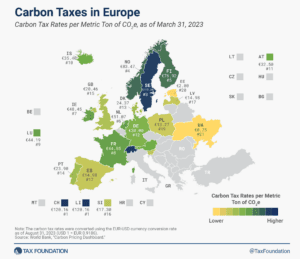
All Related Articles

Excise Duties on Electricity in Europe, 2024
EU Member States should seek to minimize the rate and broaden the base of electricity duties, consolidating their rates to the required minimum rate.
3 min read
Dividend Tax Rates in Europe, 2024
In many countries, corporate profits are subject to two layers of taxation: the corporate income tax at the entity level when the corporation earns income, and the dividend tax or capital gains tax at the individual level when that income is passed to its shareholders as either dividends or capital gains.
2 min read
Capital Gains Tax Rates in Europe, 2024
In many European countries, investment income, such as dividends and capital gains, is taxed at a different rate than wage income.
2 min read
Wealth Taxes in Europe, 2024
Only three European countries levy a net wealth tax—Norway, Spain, and Switzerland. France and Italy levy wealth taxes on selected assets.
4 min read
Savings and Investment: The Tax Treatment of Stock and Retirement Accounts in the OECD and Select EU Countries
Tax-preferred private retirement accounts often have complex rules and limitations. Universal savings accounts could be a simpler alternative—or addition—to many countries’ current system of private retirement savings accounts.
19 min read
Top Personal Income Tax Rates in Europe, 2024
Denmark (55.9 percent), France (55.4 percent), and Austria (55 percent) have the highest top statutory personal income tax rates among European OECD countries.
3 min read
VAT Rates in Europe, 2024
A few European countries have made changes to their VAT rates, including the Czech Republic, Estonia, Switzerland, and Turkey.
3 min read
Corporate Income Tax Rates in Europe, 2024
Like most regions around the world, European countries have experienced a decline in corporate income tax rates over the past four decades, but the average corporate income tax rate has leveled off in recent years.
2 min read
Comparing Europe’s Tax Systems: Individual Taxes
Estonia has the most competitive individual tax system in the OECD for the 10th consecutive year.
2 min read
Investment in the United Kingdom Increased following Pro-Investment Tax Reforms
The UK economy is experiencing an upsurge in business fixed investment following two pro-growth tax changes. In the second quarter of 2023, business investment was 9.4 percent higher than the same quarter last year.
10 min read
Comparing Europe’s Tax Systems: Corporate Taxes
According to the corporate tax component of the 2023 International Tax Competitiveness Index, Latvia and Estonia have the best corporate tax systems in the OECD.
2 min read
2023 European Tax Policy Scorecard
The variety of approaches to taxation among European countries creates a need to evaluate these systems relative to each other. For that purpose, we have developed the European Tax Policy Scorecard—a relative comparison of European countries’ tax systems.
52 min read
Real Property Taxes in Europe, 2023
High property taxes levied not only on land but also on buildings and structures can discourage investment in infrastructure, which businesses would have to pay additional tax on.
2 min read
2023 Spanish Regional Tax Competitiveness Index
The 2023 Spanish Regional Tax Competitiveness Index allows policymakers and taxpayers to evaluate and measure how their regions’ tax systems compare.
6 min read
Cigarette Taxes in Europe, 2023
3 min read
Beer Taxes in Europe, 2023
As Oktoberfest celebrations kick off around the world, let’s look at how much tax European Union (EU) countries add to the world’s favorite alcoholic beverage.
2 min read
Carbon Taxes in Europe, 2023
In recent years, several countries have taken measures to reduce carbon emissions, including instituting environmental regulations, emissions trading systems, and carbon taxes. In 1990, Finland was the world’s first country to introduce a carbon tax.
4 min read
Net Operating Loss Carryforward and Carryback Provisions in Europe, 2023
Carryover tax provisions help businesses “smooth” their risk and income, making the tax code more neutral across investments and over time.
3 min read
Patent Box Regimes in Europe, 2023
The aim of patent boxes is generally to encourage and attract local research and development (R&D) and to incentivize businesses to locate IP in the country. However, patent boxes can introduce another level of complexity to a tax system, and some recent research questions whether patent boxes are actually effective in driving innovation.
3 min read
Capital Allowances in Europe, 2023
Capital allowances play an important role in a country’s corporate tax base and can impact investment decisions—with far-reaching economic consequences.
4 min read




